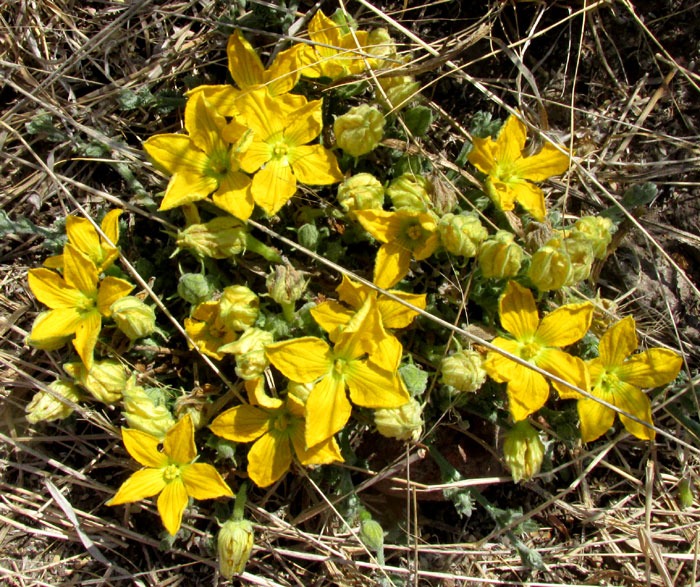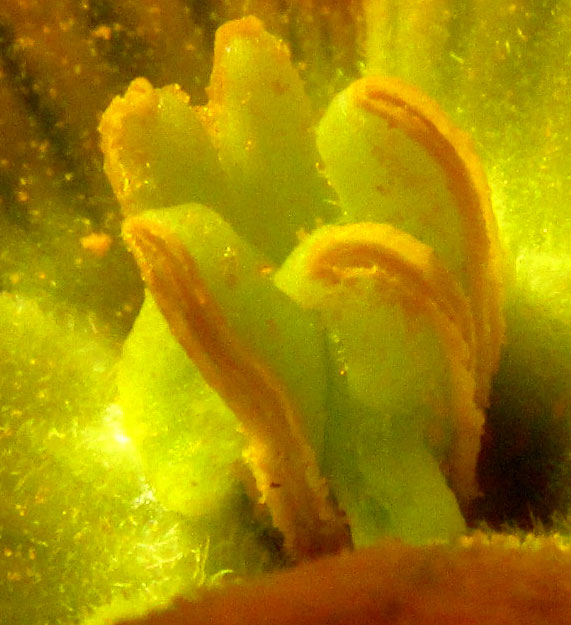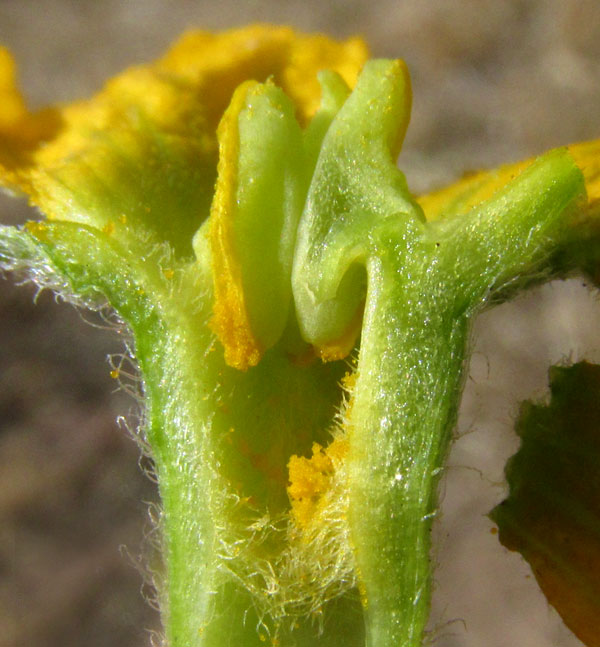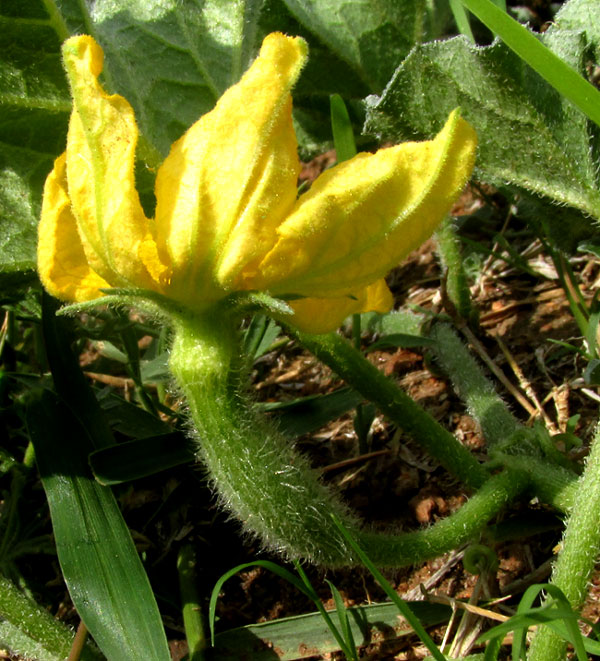Excerpts from Jim Conrad's
Naturalist Newsletter
entry dated May 26, 2022, issued from near Tequisquiapan, elevation about 1,900m (6200 ft), ~N20.57°, ~ W99.89°, Querétaro state, MÉXICO
CUCURBITA PEDATIFOLIA FLOWERING

In an overgrazed, scrubby field on the edge of town, next to a dirt trail and at the end of an especially rainless dry season -- no rain since Christmas -- the above bright gathering of blossoms stood out in the parched, gray and brown landscape. At first I couldn't imagine what kind of plant might create such a show. Then I began "doing the botany."
Some of the corollas were four-lobed, but most produced five. Also, the stamens seemed to be doing something funny, and here's what they looked like with magnification:

It looked as if on each anther face masses of pollen had turned to yellow-green wax and in the day's heat were flowing down onto the corolla. No plant family does this. A side view of a blossom provided more surprises:

The corolla's yellow lobes displayed a green network of forking veins. But is this an inflorescence of several flowers arising from a main stem, or a new stem producing flowers before leaves? On the main stem at the left, note the occasional stiff hair much longer than the others, and sticking straight out from the stem. Confusion. A blossom was dissected in hopes of gaining some insight:

As the flower was being cut open, there was an odor familiar to any gardener, that of crushed green squash leaves. Smelling that and seeing what's shown above, things began coming into focus. First, in this flower, there's no female parts; it's a unisexual flower. Second, aren't those two anthers at the far left fused together along their common side, and; third: how about if the gobs of "wax" are actually grossly thick filaments twisting up from the flower's wall (hypanthium), and the actual pollen-producing parts, the anthers, are the vertical, orangish, split-banana-looking things?
The Squash or Cucumber Family, the Cucubertaceae. That family mostly produces unisexual flowers, which are mostly yellow or orangish yellow, often with stamens grown together appearing as only three or even one, and anthers that can be fused together. And the herbage usually emits a certain squashy smell.
If this is a male plant, would there be a female around, and what would she look like?
Another plant, a meter away, also was male, but so withered from lack of rain that it was runty and produced only a single crumpled flower. About 30 meters away a female turned up, looking like this:

She was more vigorously than the males issuing stems in every direction, but there was no hint of flowers. If this plant was to be identified, probably a leaf would be needed, but you can see that the leaves were still tightly held together, no larger than 6mm across (1/4 inch). Still, with magnification, maybe they'd show their general form:

The mature blade will be very deeply 3-lobed, maybe 5-lobed. It will be unlike any leaf on the usual squash or cucumber vine.
The Squash/Cucumber Family is fairly large, with about 120 genera occurring nearly worldwide, but mostly in the tropics. About 825 species are recognized. All squash species are derived from ancestors who arose in the Americas, while all melons have ancestoral roots in Africa and Asia. Mexico is home to 38 genera in which about 141 taxa reside. In our semiarid upland region of central Mexico known as the Bajío, we have about 16 genera which include about 37 species that grow wild in the landscape. In other words, sometimes it can be hard to determine which species you have, especially when there are no female flowers, fruits, or mature leaves.
Still, all the above insights lead to this: CUCURBITA PEDATIFOLIA, with no English name, and a Spanish name, Calabacilla, which just means "little squash." It's endemic only to a small parts of San Luis Potosí and Guanajuato states, and here in the east-central part of Querétaro.
Not much is known about this plant, except this: A 2018 work by Robert Augusto Rodríguez R. and others, entitled "Características agronómicas y calidad nutricional de los frutos y semillas de zapallo Cucurbita sp." tells us that the pulp of this squash plant's fruit is fiberous and bitter, that the species hibridizes with Cucurbita ficifolia, and that it's resistant to various viral diseases affecting members of the family.
That last fact alone makes this an important species to keep in mind, in case anyone ever wants to insert genes from it into an important garden species vulnerable to common viral diseases.
But even without that, it's something to have a little wildfower capable of producing such an encouraging bouquet of vigorous yellow blossoms at the end of a an exceedingly dry dry season that just goes on and on.
entry dated June 26, 2022, issued from near Tequisquiapan, elevation about 1,900m (6200 ft), ~N20.57°, ~ W99.89°, Querétaro state, MÉXICO
FEMALE FLOWERS & FIRST SQUASH

In a large, grossly overgrazed and eroded abandoned field a wild squash caught my eye because its leaves had the form of those of Cucurbita pedatifolia, and this plant was bearing the immature squash shown above. Exactly one month earlier I'd been unable to find a female plant with either a flower or a immature fruit.
But during a month this female plant had grown much larger than any of the Cucurbita pedatifolia plants seen earlier. In fact, once the squash was photographed, finally I noticed that on the plant's sprawling far side the female flower shown below was blossoming:

Note the hairy ovary -- the future squash -- below the corolla. Here's what the flower's interior looked like:

I read in various sources that female flowers in the genus Cucurbita have three stigmas, which are divided. The above picture seems to show four divided stigmas. Whatever the case, here's a picture of the whole plant -- its lone flower visible at the far right -- giving an idea of the kind of desolate and grazing-animal-abused landscape in which this species seems to thrive:
